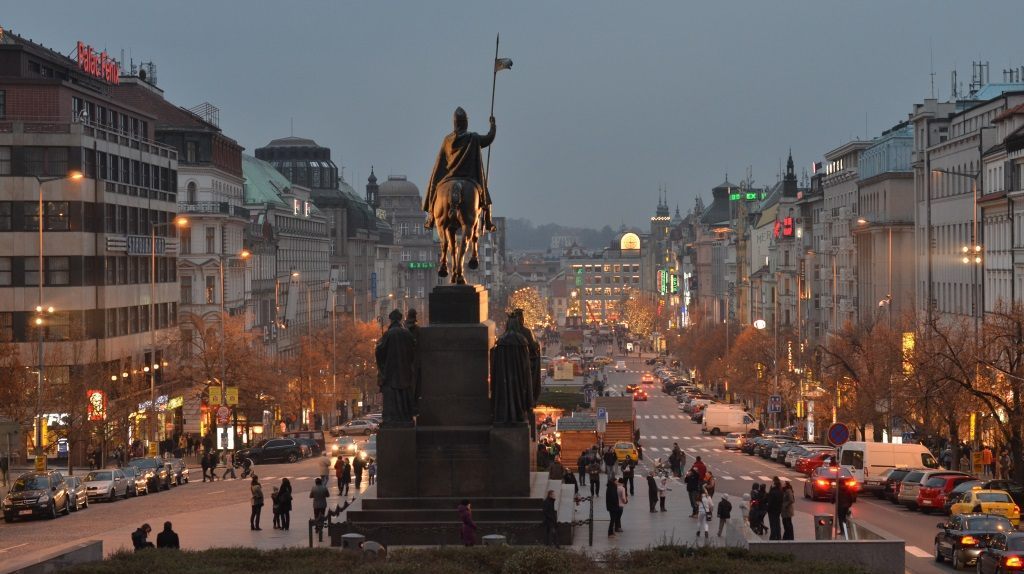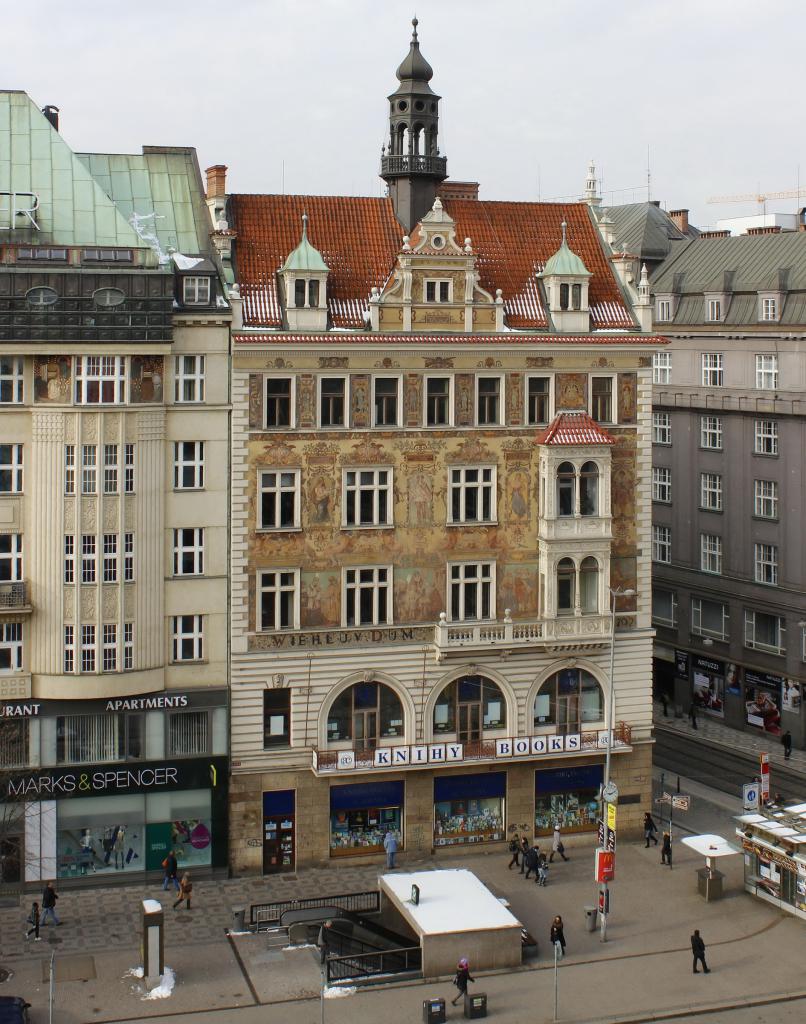The cultural and business center of Prague - Wenceslas Square. This is one of the most famous and visited boulevards in Europe and the largest square in the country, which all residents of the capital simplistically call Watslak. 750 m long and 60 m wide, the square spreads in the New Town (Nové Město) from the National Museum to Na Můstku Street - the border of the Old Town. The square has witnessed important historical events. This is a traditional venue for demonstrations, celebrations, concerts and other public events. According to the historian Dusan Třeštík, Wenceslas Square is the point by which the pulse of the whole country is determined, there is a place where the most significant signs of modern Czech history are collected.
Location and layout
In the lower part, the square begins at the junction of three streets: the end of Na Můstku, October 28 (28. Října) and Na prikop (Na příkopě). Along Na Můstku Street, a bridge once passed to the gates of the city wall through a fortification gutter. Hence the name of the street on the bridge. Perpendicular to Wenceslas Square and Na Můstku, left and right, there are 28. Října and Na příkopě. In the tourist season, the lower territory of the square, like the Charles Bridge, is full of spectacular entertainments: puppeteers, potters, blacksmiths, jugglers, living statues, musicians demonstrate their skills. Here, local guides offer services, and among them there are many who are fluent in Russian.
At the corner 28. Října and Na Můstku there is the Mustek metro station, so getting to Wenceslas Square is not difficult. The numbering of houses starts from here: even numbers are located on the right side and end at number 66, odd numbers are on the left with the last building at number 59.
The middle of the square is a wide pedestrian zone, where exhibitions of modern art are held, and Czech artists demonstrate their incredible large-scale sculptures in the open. In the middle pedestrian zone there is a cafe-tram, an attractive institution with an open area and a hall for visitors in the tram itself. Approximately in the middle of its length, the square forms a crossroads with the streets Vodičkova and Jindřišská. This spacious avenue ends with the building of the National Museum, the facade of which, combined with the equestrian monument to St. Wenceslas, has become the most recognizable symbol of Wenceslas Square in the photo.
On both sides of the avenue there are many coffee houses, restaurants, snack bars, exchange offices, shops, including jewelry with famous Czech grenades. But you should know that the prices here are significantly overpriced, and currency exchange is not the most profitable. If you move from the side of the street “On prikop”, then it’s better to go to the bank, where at the same time you can see the stunning paintings of Alphonse Mucha.
National Museum
The construction of the museum building designed by Joseph Schulz lasted 15 years and ended in 1890. Neo-Renaissance construction with a facade with a length of 100 m and a height exceeding 70 m, is located at the end of the square and dominates the layout of the entire adjacent territory.
Above the fountain of the facade are three sculptures, symbolizing the historical regions of the Czech Republic. The average, most significant female figure of the patroness of arts and science embodies Bohemia - an area that occupies half of the country. Sculptures of a young virgin and an old man - an allegory of Moravia and Celesia.
Above the museum's windows of the facade, 72 names of prominent figures in the history of the state are displayed in gold. And under the central glazed dome, sculptural images of Czech cultural figures are exhibited. The National Museum consists of several branches located in different places of the city. This historical building of the museum on Wenceslas Square is considered the main one, it houses the library, the natural-scientific and historical departments. Of particular interest is the archaeological exhibition on the second floor and the paleontological collection on the third.
On the facade masonry, fragmentation damage can be seen. These are commemorative marks of the battles of 1968, when Soviet troops were brought into Czechoslovakia, according to the Warsaw Pact. This museum building is located at Wenceslas Square 1700/68 Prague1, and its numbering refers to the only end room.
Monument to St. Wenceslas
Deep meaning is not only the equestrian statue of the canonized Czech prince, but the overall composition of the monument. St. Wenceslas is the main patron of the country. He is surrounded by four more holy saints, the most important patrons of the Czech land: St. Agnes, St. Ludmila, St. Procopius, St. Wojtech. And this is symbolic both for the capital and for the entire state.

All sculptural figures were created by the ingenious Czech sculptor Josef Myslbek, who embodied his sculptural portrait in the person of St. Procopius. The general architectural design belongs to Alois Dryak, and the original ornament of the monument was carried out by Zelda Klouchek. All bronze castings were made by Bendelmayer. Over 30 years, work has continued, from the project to the installation of the monument. The composition was established (1912) at the beginning with three statues of saints, the fourth figure appeared only 12 years later, and the celebration of the final opening of the monument took place in 1935.
In memory of Jan Palach
In front of the very steps of the museum, on the bridge of Wenceslas Square, you can see a cross as if fused into mangled cobblestones. This is the memorial site of the death of Prague student Jan Palach, who burned himself in 1969, protesting in such a fatal way against the Soviet occupation of Czechoslovakia. His action led to mass outrage and demonstrations. 32 years later, Jan Palach was awarded posthumously the Order of the First Degree by Tomas Masaryk.
Sights of the even side of the square
Half of the Wenceslas Square houses are owned by foreign citizens from Austria, the UK, the USA, Ireland, Russia and Germany. Most buildings are called palaces, that is, palaces. Moving along the houses with even numbers in the direction of the museum, the first palace to be seen will be the newest building.
Palac Euro (No. 2). This is the last of the buildings built on the square, its construction was completed in 2002. It has a unique system of environmental control and changes in external lighting. Euro Palace is an end building, completely covered with glass, and looks especially interesting with evening lights.
At number 6, is the 1929 Baťa Shoe House. This is the first reinforced concrete structure in the country with a suspended glazed facade, a monument of architecture since 1964. The once-famous Czech shoe company is today owned by Bata & Co. (Netherlands, Canada).
Franciscan Garden
Through the arched passage Palác Alfa (No. 28) by architect Ludwik Kisel, you can go to the Franciscan garden and get into another world, separated from the hustle and bustle. Quiet, relaxing, seductive Franciscan garden overlooking the Church of Our Lady of Snow (Panny Marie Sněžné) and the complex of the former Franciscan monastery. The Church of Our Lady of Mary was founded by Czech King Charles IV in 1347 as a temple dedicated to coronation. The church was supposed to be larger than St. Vitus Cathedral and reach a length of 100 meters, with a nave 40 meters high. Hussite wars violated the implementation of a bold project, and only the presbytery was completed. But even today's appearance of the church and its size can tell how magnificent this church is.
Beautiful house of mercy
An interesting is the corner of Wenceslas Square and Vodičkova Street. No. 32 is occupied by the Palace of Ligna. In 1947, the Světozor passage was built here, adjacent to the Alfa passage and overlooking the Franciscan Garden. Bypass passages are a Prague architectural phenomenon, adapted to meet the needs of a modern metropolis in the conditions of the old building, allowing you to create new shopping and entertainment areas without claiming additional street space.
The next corner house (Václavské náměstí 34, Vodičkova 40) is probably the most beautiful on Wenceslas Square in Prague. A photo of Vilya House is featured in all guides of the Czech capital. Initially, there was an ancient building with a brewery, demolished by Antonin Willem - architect and owner of many monumental buildings. On the site of the brewery, Ville in 1895-1896 built one of the most amazing houses of the Czech Neo-Renaissance with rich genre painting by Mikolas Ales and Joseph Fanta.

One of the distinguished buildings is a complex of three multi-purpose buildings forming the corner of Wenceslas Square and Štepanska Street (No. 38; No. 40 - Štěpánská No. 65). This ensemble was built between 1912 and 1916, according to the projects of Emil Kralik, architect of the modernist era and Czech cubism. The complex is often referred to as Šupichovy domy. This building is characterized by cubism geometry with modern elements contrasting on the facade of the building: the separation of gray masonry, rough surface of the stucco and fine geometric finish. An extensive walkway system is suddenly discovered inside the complex: the geometrically elegant Rokoko passage with a stunning umbrella dome; Art Nouveau Lucerna passage with entrance to the cinema of the same name and a fantastic courtyard.
The odd side of the square
The opposite side of the square also contains many architectural sights. Hotel Jalta (No. 45) was built in 1958 according to the design of Antonin Tenzer in the style of late socialist realism with the influence of functionalism. In late Socialist Realism, communist symbolism was almost never used, ornamental geometric forms were used to a greater extent. In the design sense of its time, this building is very successfully completed. Unique is the hotel's underground shelter with reinforced thick walls and a special coating, which were supposed to prevent the penetration of radiation after a nuclear explosion.
Interior for the Titanic
No. 25 - Europe Hotel (Grandhotel Evropa) was formerly called the Grandhotel Schrubeck, and was originally built (1872) in the spirit of the Neo-Renaissance. The hotel was rebuilt in the Art Nouveau style since 1905. In fact, these are two houses, one with a facade on the street, the other in the yard. It was a very prestigious, luxurious and modern hotel of its time, but its traditions suffered after the nationalization of 1951. In 2016, reconstruction began with the expansion of a new building in the courtyard to increase the hotel's capabilities. In the basement of the building is the Pilsen Restaurant. A hotel cafe in the Art Nouveau style is considered the most beautiful in Prague and served as a source of inspiration for the restaurant interior of the film "Titanic". Also, the richly decorated interiors of the hotel have repeatedly become the scenery of films, the most famous of which was the 1996 film "Mission Impossible."

The corner of Wenceslas Square No. 19 and Jindrisska Street No. 1 and No. 3 is occupied by Assicurazioni Generali. Here, in the building of the former branch of the Italian insurance company, from 1907 to 1908, Franz Kafka worked. This "palace" was built (1848) in the neo-Baroque style by architects Bedrich Ohman and Osvaldo Polivki.
No. 5 - Ambassador Hotel with a passage, Alhambra cabaret, cinema, casino. The building was originally a department store, erected in the years 1912-1913 by the design of Frantisek Setr, then rebuilt from 1922 into a late modernist style hotel.
How to get there
Wenceslas Square in Prague is located above the metro line, the two busiest stations of which, Muzeum and Můstek, go out at the beginning of the square and at the end (behind the museum). These stations form the shortest stage of the metro. Car traffic is allowed on the square, except for the northwest pedestrian zone.